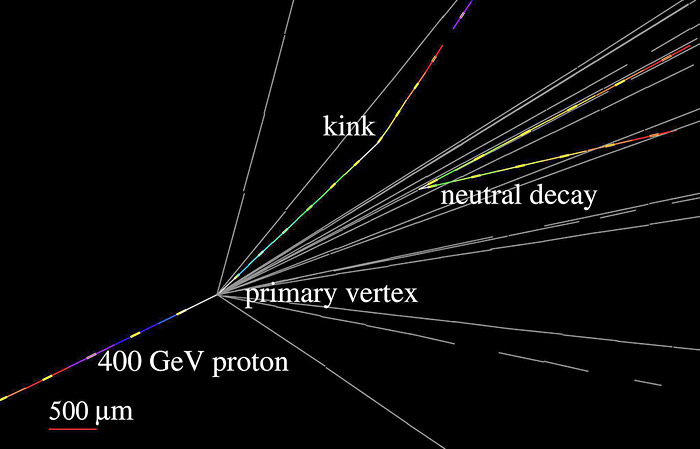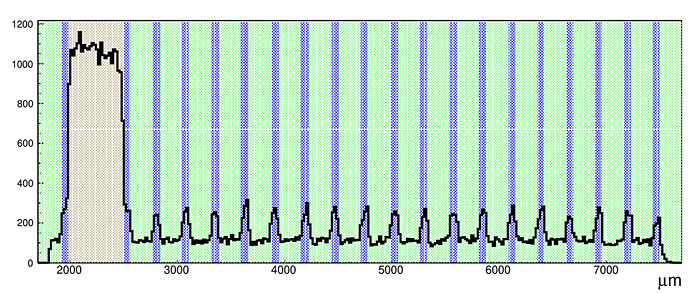
Electronic english version since 2022 |
The newspaper was founded in November 1957
| |
|
Number 9 (4707) |
Personal dimension
Once at JINR, forever at JINR
Junior researcher of the Department of Elementary Particle Physics of DLNP Madelina-Mihaela MILOY believes that her destiny is inextricably linked with our Institute. She likes the scientific task, the staff and the city. Today, she talks about all this on the pages of our weekly.
 I was just finishing the 2nd year of Bachelor's studies when I visited JINR for the very first time. It was in 2015. University of Bucharest, where I studied, used to send its (very active) students for summer practice in JINR. For me Dubna was "love at the first sight". At that time I was working for 3 weeks in the DLNP group for investigations of genetic mutations on Drosophila melanogaster. I loved everything that happened in those 3 weeks, from the work itself, to the atmosphere of the city - calm, somehow isolated, so a perfect place to stay together with my thoughts.
I was just finishing the 2nd year of Bachelor's studies when I visited JINR for the very first time. It was in 2015. University of Bucharest, where I studied, used to send its (very active) students for summer practice in JINR. For me Dubna was "love at the first sight". At that time I was working for 3 weeks in the DLNP group for investigations of genetic mutations on Drosophila melanogaster. I loved everything that happened in those 3 weeks, from the work itself, to the atmosphere of the city - calm, somehow isolated, so a perfect place to stay together with my thoughts.
After 2015, I returned each year to JINR for schools or student practices but also for my very first working contract. Since January 2017, I have worked in FLNP for one year. It was one of the most challenging years in my life, not only because of the problems at personal level, but also because my work required knowledge I was not prepared for in university. I was still studying engineering (Bachelor's studies - Technological Physics) when I started to work in the field of ultracold neutrons. I had the graduation exam and the admission exam for the Master Degree within the year I was working in FLNP. Even so, I consider it was the right choice for me, not only because I wrote the very first codes that produce a result, but especially because I learned and evolved a lot in that year. When I finished high school (it was one of the oldest and most prestigious in Romania), we were told that the highest quality steel has to pass through fire. I see this experience through this point of view. The biggest evolution I had in university was due to my contract in FLNP.
At the beginning of my PhD studies in University of Bucharest, in the middle of the pandemic in 2020, I decided to return to JINR. "Once in JINR, forever in JINR". This decision should not be a surprise for anyone, all the contribution I had in the places I worked in the meantime was mostly due to what I learned in JINR. Clearly, my place is in JINR, both for personal reasons (here I feel I belong to) but also because here I have people that have similar ways of thinking and working as I do. Here, I have the freedom to evolve as much as I have powers to and colleagues appreciate when they see me contributing.
Even the people from my university (including professors) felt that my place was in JINR and expressed it with every occasion.
Today, I am employed in DLNP and my room is on the same corridor where genetic investigations are carried out, but on the 'Physics side'. Maybe, this is not a coincidence.
My main work is dedicated to the NA65 (DsTau) experiment that estimates the flux of the tau neutrino produced in proton-nuclear interactions. The experiment can detect charm particles, in particular, the Ds meson that is of interest since it is the main source of tau-neutrino in accelerators. It is a CERN experiment that uses nuclear emulsion films as tracking detectors. The facility consists of more than one hundred units, each having 10 tungsten (or molybdenum) targets followed by 10 emulsion plates (emulsion gel poured on both sides of a plastic base) that are separated by plastic foils.
Each unit was exposed individually at 400 GeV protons from SPS, without any magnetic field, but exposed in a uniform way in order to reach 3х105 protons/cm2. For this, each unit is put on a target mover that moves it in front of the beam, according to intensity (that is not constant). Depending on luck, the full exposure of one unit can last 40 min or… even 2 days if SPS unexpectedly stops operating. And SPS often gave us such surprises! We divided our data taking campaign into several years and we finished it in 2023.

Photo of me installing the Target Mover in the beam-line, in 2021
Right after the exposure, the emulsion films (that are 'old-style' photographic plates, with a modified chemical composition and in which the charged particles leave traces around their trajectories) have to be chemically developed. The development itself happens in a dark room (so in darkness) and it is not a trivial procedure. It requires attention and precision, since there are thousands of plates that have to be developed fast and they can stick or get damaged in the process. After the development, the plates are not sensitive anymore and cannot register any trajectory of any particle. The emulsions we used have an intrinsic angular resolution of 0.35 mrad and a spatial resolution of 0.4 microns.
 |
| Together with my Japanese collaborator, near a unit, ready for exposure. Also, this is proof I wear my T-shirts with JINR logo when I represent the Institute, 2021 |
All of the above mentioned procedures require specific algorithms that have to operate fast while searching in a huge pile-up of traces. The search for short-lived particles emitted in the forward direction, like charm particles that are invisible for many detectors, is not trivial. The particles we search for in our experiment decay within millimeters, but their decay products can travel longer distances. Background extraction requires specific algorithms. The development of algorithms is the main task of the DsTau experiment at this moment and it's very challenging.

Example of a reconstructed primary vertex where charm candidate events are developed
My main contribution is in data analysis and one of the tasks is particularly dedicated to the development of the algorithms that extract the resolution of reconstruction, together with the thickness of each structural layer of the detector. Even if the main interest of the experiment is in the interactions occurring in the tungsten targets, nothing stops the incoming protons from interacting in all structural materials of the detector. Therefore, by reconstructing the primary interactions in all materials, the position of each layer can be distinguishable by the amount of interactions occurring in it.
The interactions occurring in the first tungsten target followed by emulsion and plastic layers are presented in the Figure. The fine structure of the detector is visible. The reconstruction is performant enough to show interactions occurring in layers of small thicknesses (emulsion has only 70 microns and plastic around 200 microns). The position of the tungsten target (with a nominal thickness of 500 microns) is distinguishable by the biggest amount of interactions (is marked with a gray background). The smaller peaks, on blue background, correspond to the interactions occurring in emulsion layers. The 'flat' areas with green background are the interactions in plastic (this is not background). The chemical composition of the emulsion differs from the plastic one by having an additional big concentration of AgBr crystals that are definitely heavier targets than C or H, of which plastic consists. Why does the emulsion gel contain AgBr crystals? Because exactly those crystals help in the formation of the image in the photographic plate, the trajectory of the charged particle that ionizes the environment around its 'journey'.

Subsample of reconstructed primary vertices along the beam axis, in one unit. The position of the tungsten target is distinguishable by the biggest amount of interactions. The target is followed by layers of plastic and emulsion, where vertices could have been identified as well, despite of the small thicknesses (the thickness of the target is 500 microns, the emulsion layer is 70 microns and the plastic layer - around 200 microns)
To obtain the resolution of reconstruction along the beam axis and as well, the real thickness of each layer (that can be different than the nominal values), each of the peaks is fitted with a convoluted function. The convolution is developed by a box function with podium structure, where all limits of each step are free parameters and a normalized Gauss. For the real data, the extracted resolution of vertex reconstruction along the beam axis is around 7 microns. The extraction of resolution was followed by a thorough investigation of its dependencies: a vertex is better reconstructed when more traces contribute at its reconstruction (the higher the multiplicity, the more precise the vertex reconstruction), a vertex is better reconstructed when the first registered trace segments, the basetrack, are closer (the resolution depends on the position inside the target). The resolution also depends on the flatness of each layer, as well as the quality of the emulsion layer (damaged or not). All this work helps at a precise selection of interactions in targets and it was my main focus during the last months.
Since the standard algorithms work slowly (too slowly!), JINR develops new algorithms for vertex reconstruction, including the selection of the primary vertices and for search of short lived particles, followed by Ds decaying tau search. I have already joined this work and soon it will be my main focus. Our preliminary work shows that our algorithms are significantly faster but I will present our new algorithms with their results at the future conferences.
I consider I have made the best decision to stay at JINR. Not only because I can do what I like and I can be paid for it, but also because the city fulfills my requirements for happiness: kind of calm and isolated, with forest, lots of birds, I can do the sport I like, I can find friends as I like. I feel that all the experiences I have passed through in this life prepared me to be here now and have made me more powerful to face the challenges that will appear... and I am sure the next years will be full of challenges.